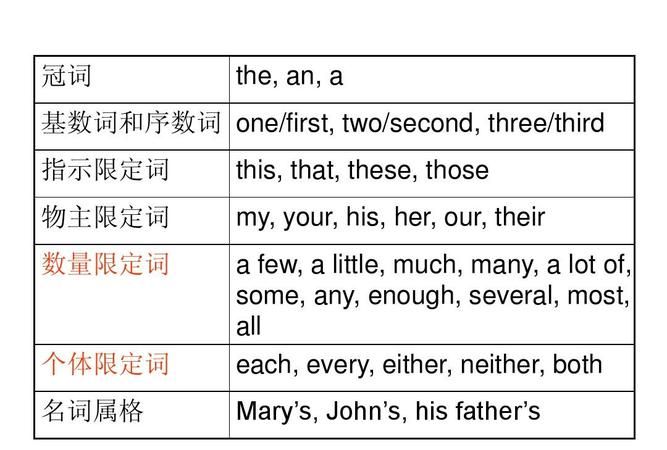本文目录
有的时候会看到语法书上说限定词balabala 比如some+名词=some of+限定词+名词
1、限定词就是规定并限制名词范围的词,包括冠词、物主代词、指示代词、不定代词、数词等。
2、不定代词具有双重词性:形容词性和名词性。如 some books 是形容词性;some of the books 是名词性。这两种表达方式意思差不多,但不能完全划等号,前者指不知详情的 “几本书”,后者指已知的 “这些书中的几本”。

限定词的用法总结
(一)、数量限定词:表示一些的词有 :a few, few; a little ,little 。
这四个词均可以表示一些,但是 a few 和 few用于可数名词,表示一些 :
例如:
a few cakes, a few trees, few apples, few oranges.
a little 和 little则修饰不可数名词 :
a little water, a little paper.
a few 和 few在用法时,a few和a little 用于肯定句,表示:还有一些;few和 little用于否定句,表示虽然有,但不多。
例如:
His story is very old-fashioned, few people are interesting.
他的故事很老套,很少有人感兴趣。
His story is very old-fashioned, a few people are interesting.
他的故事很老套,有一些人感兴趣。
alittle 和little也有类似的用法:
I have little interest in basketball,so I don't like play it.
我对篮球不太很感兴趣,所以不太喜欢玩它。
I have a little interst in basketball, so I like play it.
我对篮球感兴趣,因此我喜欢玩它。
(二)、数量限定词: some 和 any
的用法, 这两者均表示一些且均可以放在不可数名词或可数名词的复数之前:
some用于肯定:
There has some trees in the street, if we want to escape the sun, we should go to shadow.
街上有一些树,如果我们想要远离太阳的话,那就应该去树荫处。
any用于否定句:
I don't have any friend here.
我在这儿没有朋友。

有没有 不定代词比如some+of+限定词 +名词的用法 我看到的貌似都是some of th
常规情况下都是
“不定代词+
of/in+限定词(these,
the,
our,
my....)
+名词”。原因如下:1.
因为英语名词区分特指和泛指,如some
of
our
students中,our
students就是特指,只有在特定范围内,才可能再指some。2.
some后的介词短语用来修饰some,介词短语本身就是反映客观世界的空间或时间方位,具体的、限定的更合乎认知常识。

限定词的用法总结
下面介绍一些限定词(包括相应的不定代词〕的某些习惯用法问题。
(1〕many,much,a lot of,lots of,plenty of
表示多的意思,可用many,much,a lot of,lots of,plenty of等。但是many,much常用于否定句和疑问句,而a lot of等则常用于肯定句。
I haven't seen many English films. 多数英文电影我没看过。many修饰可数名词
I haven't done much work today. 我还没有做多少活呢。much修饰不可数名词
many / much常用于否定句和疑问句并不是绝对的,尤其是在下列场合many / much也常用于肯定句:
a) 用于whether / if引导的宾语分句中。
I doubt whether / if there'll be many people at the show on this rainy day. 我怀疑在这个雨天里会有很多人看表演。
b) 用于由how / too / so / as+ many / much (+中心词) 构成的名词词组中。
He took so many boxes with him that he had to call a taxi. 他身边带着太多的箱子,不得不叫计程车。
c) 用于在句首作主语以及在存在句中作实义主语的名词词组中。
Many people would like to take holidays abroad. 许多人喜欢去国外度假。
2) (a) few,(a)little
表示少的意思,可用(a) few,(a) little,既可用作限定词,也可用作不定代词。a few,a little表示少量,带有肯定意义。
Here are a few more books on this subject. 在他的课题上有少量的书。
few / little 若不与a 连用则表示-否-定-意义,相当于not many / much,not enough。
I have very few (chocolates) left. 我剩下不多的巧克力。
little 的比较级和最高级是less 和least,通常只能用与不可数名词搭配,但在当代英语中也有用less与复数搭配的。
If only there were less holes in the roof. 如果房顶仅是少量洞。
3) some,any
要表示一些的意思,可用some,any。some 是肯定词(ASSERTⅣE WORD〕,常用于肯定句;any是非肯定词(NONASSERTⅣE WORD〕,常用于否定句或疑问句。
I seldom get any sleep these days.
any也常用于条件分句以及带有否定含义的句子中:
I forgot to ask for any change. 我忘了要一些零钱。
当some与单数可数名词搭配时,some相当于a certain(某一〕的含义;而any与单数可数名词搭配,则相当于 eery(任何一个〕的含义
Any child could answer that question. 任何一个孩子都可以回答这个问题。
4) all,both,every,each,either,neither,any
这一类词,除every只能作限定词外,都是既可作限定词,也可作不定代词。
any boy / any (one) of the (three or more) boys,
a) 表示全体,可用all 和both,但all表示三个或三个以上人或物的全体,而both则表示两个人或物的全体。
All the four applicants are below the average. 所有这四位申请者都在平均数以下。
如果要表示全体都不的意思,当全体为三个或更多的人或物时,通常用none。
None of the students failed the examination. 没有一个学生考试失败。
如果要表示两个人或物都不,通常要用neither:
Neither student / Neither (one) of the (two) cars was made in Japan. 两辆车没有一辆产自日本。
b) 表示全体中的每个,如果这个全体包含三个或更多的人或物,通常用every。
Every student in the class took part in the performance. 这个班的每个学生都是这个表演的一部分。
如果这个全体包含两个或两个以上的人或物,便可以用each
Each / Every side of the square was crowded with people. 广场的边上挤满了人。
every 与each 的区别还在于every 指许多人或物中的每个,侧重在全体,近乎all的含义:
Every student failed the examination. = All the students failed the examination. 所有的学生都考试失败。
c) 表示全体中的任何一个,也要看这个全体是包含三个或更多,还是只包含两个。当全体包含三个或三个以上,要表示其中任何一个须用any。
Any (= Every) child would know that. 每个孩子都知道这个。
当全体只包含两个时,要表示其中任何一个须用either。
We have two copies left. Keep either (copy) for the file. 我们有两份考贝剩下,为文件保持其中的一份。
但在on either side,on either end等固定词组中有时可以兼指两个。
There are stairways at either end of the corridor. 走廊的两头都有楼梯。

以上就是关于限定词加名词的用法,英语中修饰可数名词和不可数名词的限定词的用法的全部内容,以及限定词加名词的用法 的相关内容,希望能够帮到您。

